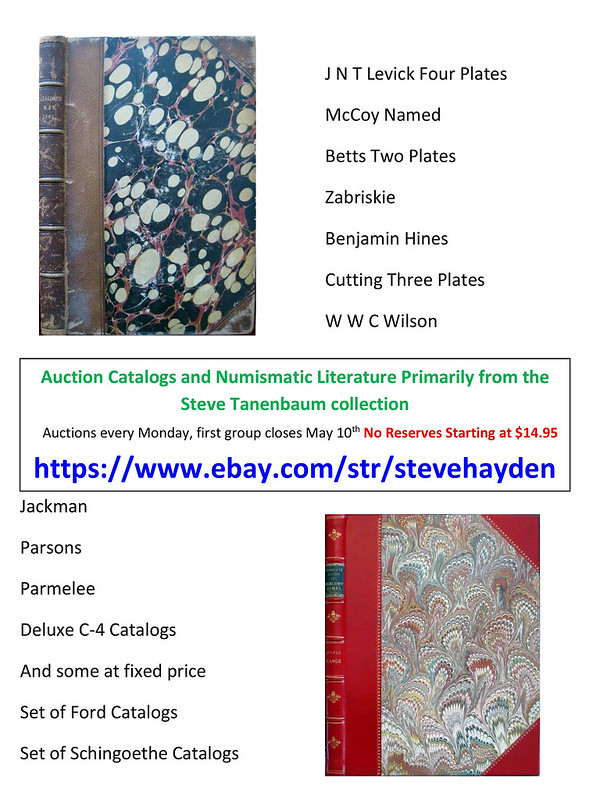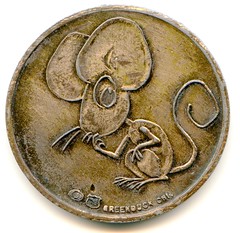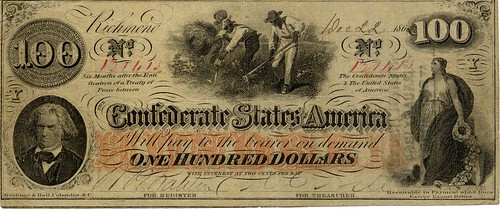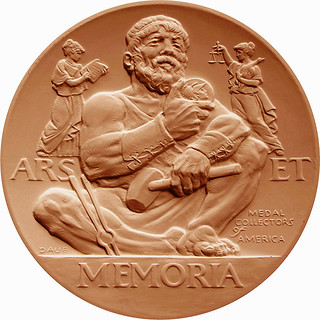
Visit our NBS Sponsors


|
About Us
The Numismatic Bibliomania Society is a non-profit association devoted to the study and enjoyment of numismatic literature. For more information please see our web site at coinbooks.org SubscriptionsThose wishing to become new E-Sylum subscribers (or wishing to Unsubscribe) can go to the following web page link MembershipThere is a membership application available on the web site Membership Application To join, print the application and return it with your check to the address printed on the application. Print/Digital membership is $40 to addresses in the U.S., and $60 elsewhere. A digital-only membership is available for $25. For those without web access, write to: Charles Heck, Treasurer AsylumFor Asylum mailing address changes and other membership questions, contact Chuck at this email address: treasurer@coinbooks.org SubmissionsTo submit items for publication in The E-Sylum, write to the Editor at this address: whomren@gmail.com BUY THE BOOK BEFORE THE COIN |
- WAYNE'S WORDS: THE E-SYLUM MAY 9, 2021
- NBS BIBLIOTALK PODCAST WITH SHANNA SCHMIDT
- KOLBE & FANNING AUCTION SALE 160 HIGHLIGHTS
- NEW BOOK: WEST AFRICAN MANILLA CURRENCY
- NEW BOOK: CONGRESSIONAL GOLD MEDALS
- NEW BOOK: CHEMICAL AND PETROLEUM CURRENCY
- JOHN S. DYE AND HIS COUNTERFEIT DETECTORS
- VIDEO: QUEEN VICTORIA'S NUMISMATIC FAMILY TREE
- ANA TO DEACCESSION ITEMS ON EBAY
- THE JOURNAL OF NECROMANTIC NUMISMATICS
- NOTES FROM E-SYLUM READERS: MAY 9, 2021
- QUERY: GREENDUCK MOUSE AND TARZAN PIECE
- MORE ON INFLUENCE IN NUMISMATICS
- JEWISH-AMERICAN HALL OF FAME WEBSITE UPDATED
- BORCKARDT RECEIVES EAC'S SILBERMAN AWARD
- MICHAEL OLSON RECEIVES MINT DIRECTOR’S AWARD
- VOCABULARY TERM: DROP HAMMER PRESS
- MORE ON DAVID ULYSSES PROSKEY (1853-1928)
- HARVEY STACK'S NUMISMATIC FAMILY, PART 95
- THE COIN ANALYST: CELEBRATING 10 YEARS
- CHARLES I SHILLING AT MARYLAND COLONIAL FORT
- 2021 ANS COINAGE OF THE AMERICAS CONFERENCE
- 2021 ANA SUNDMAN AND MONEY TALKS SPEAKERS
- 2021 ANA WORLD'S FAIR OF MONEY CONFIRMED
- ARCHIVES INTERNATIONAL AUCTION 67
- MORE HOLABIRD MAY 2021 SALES SELECTIONS
- FOUNDATIONS OF THE FIRST MONETARY SYSTEM
- PAQUET 1861-S DOUBLE EAGLE OFFERED
- U.S. COIN COMPOSITION CHANGES
- 1854 RESCUE OF THE S.S. SAN FRANCISCO MEDAL
- CONFEDERATE MONEY AFTER THE CIVIL WAR
- VIETNAMESE PHAN BOI CHAU NOTES
- LOOSE CHANGE: MAY 9, 2021
- FEATURED WEB SITE: MEDAL COLLECTORS OF AMERICA
Click here to read the thin version on the web
Click here to subscribe
Click here to access the complete archive
To comment or submit articles, reply to whomren@gmail.com
Content presented in The E-Sylum is not necessarily researched or independently fact-checked, and views expressed do not necessarily represent those of the Numismatic Bibliomania Society.
WAYNE'S WORDS: THE E-SYLUM MAY 9, 2021
 New subscribers this week include:
Henry Nagtegaal of the Edmonton Numismatic Society, courtesy Dan Gosling and Wayne Jacobs;
Alvaro Rodriguez, also of the Edmonton Numismatic Society;
Michael Balwierczak, courtesy of Andy Singer; and
Alexander Lyzohub. Welcome aboard! We now have 6,639 subscribers.
New subscribers this week include:
Henry Nagtegaal of the Edmonton Numismatic Society, courtesy Dan Gosling and Wayne Jacobs;
Alvaro Rodriguez, also of the Edmonton Numismatic Society;
Michael Balwierczak, courtesy of Andy Singer; and
Alexander Lyzohub. Welcome aboard! We now have 6,639 subscribers.
Thank you for reading The E-Sylum. If you enjoy it, please send me the email addresses of friends you think may enjoy it as well and I'll send them a subscription. Contact me at whomren@gmail.com anytime regarding your subscription, or questions, comments or suggestions about our content.
This week we open with a new NBS podcast, four new books, and plans to deaccession material from the ANA Museum and Library.
Other topics this week include the Journal of Necromantic Numismatics, the Greenduck Company, the Jewish-American Hall of Fame, the drop hammer press, ANS and ANA speaking opportunities, auction previews, the Paquet 1861-S Double Eagle, and the Medal Collectors of America.
To learn more about the Boeing & Bridgman collections, West African Manilla currency, Congressional Gold Medals, the Robert J. Bauman Collection, John S. Dye and his counterfeit detectors, The Banknote Book, influence in numismatics, Mark Borckardt, Michael Olson, David Proskey, Richard Picker, Louis Golino, the Victor D. Brenner sesquicentennial, the Imperial Bank of Persia, the bronze age origins of the first monetary system, U.S. circulating coin compositions, the rescue of the S.S. San Francisco, secret society medals, and Barnumesque humbugging, read on. Have a great week, everyone!
Wayne Homren
Editor, The E-Sylum
NBS BIBLIOTALK PODCAST WITH SHANNA SCHMIDT
The latest episode of the Numismatic Bibliomania Society podcast is now available for listening. It's on the NBS web site but also available elsewhere. Vice-President/Secretary Len Augsburger provided this report. -Editor
NBS Podcast Features Shanna Schmidt
 The latest episode of the NBS podcast Bibliotalk is now available. Producer Lianna Spurrier interviews ancient coin dealer and ANA Governor Shanna Schmidt on the subject of ancient numismatics and the related literature. Shanna discusses the challenges of building a library from scratch, and the relationship between print and digital resources.
The latest episode of the NBS podcast Bibliotalk is now available. Producer Lianna Spurrier interviews ancient coin dealer and ANA Governor Shanna Schmidt on the subject of ancient numismatics and the related literature. Shanna discusses the challenges of building a library from scratch, and the relationship between print and digital resources.
The interview further covers recommendations for forming a library related to ancient numismatics, and compares various aspects of collecting ancient coins vs. collecting U.S. coins. Schmidt is a dealer in the Chicago area who is active in auction representation, especially in European sales, in addition to offering coins at fixed prices.
KOLBE & FANNING AUCTION SALE 160 HIGHLIGHTS
Here are some more highlights of the Kolbe & Fanning sale announced last week. -Editor
May 22 Book Auction Highlights
 Kolbe & Fanning Numismatic Booksellers are holding our Sale 160 on Saturday, May 22, 2021. The 459-lot auction features additional material from the library of Richard Margolis, along with properties belonging to several other consignors. Offered within are books, catalogues and periodicals covering a variety of numismatic topics, including standard current works, antiquarian volumes, rare plated catalogues, and much else.
Kolbe & Fanning Numismatic Booksellers are holding our Sale 160 on Saturday, May 22, 2021. The 459-lot auction features additional material from the library of Richard Margolis, along with properties belonging to several other consignors. Offered within are books, catalogues and periodicals covering a variety of numismatic topics, including standard current works, antiquarian volumes, rare plated catalogues, and much else.
Some highlights of the sale include:
NEW BOOK: WEST AFRICAN MANILLA CURRENCY
A CoinsWeekly article by Ursula Kampmann alerted me to a new book in English on the West African Manilla money. Here's information from the publisher's website. -Editor
 The West African Manilla Currency
The West African Manilla Currency
Research and Securing of Evidence from 1439-2019
Rolf Denk
Hardcover
€ 35.00
VAT included.
Number of pages: 292
ISBN: 978-3-347-01539-5
Size: 20.0 cm x 28.0 cm
Release date: 04/11/2020
Prof Dr Rolf Denk, born in Düsseldorf in 1935, worked as a dermatologist in the Mainz University Hospital and afterwards in his own specialist practice in Rüsselsheim. In 1978 he and other collectors were among the founders of the European Union to Search for, Collect, and Preserve Primitive and Curious Money (EUCOPRIMO). In 1981 he took over the editing of the journal Der Primitivgeldsammler. After completing his medical career, he devoted himself more to the research of early indigenous means of payment. 110 own publications have appeared on this topic. In 2017 he published the monograph "Das Manillen–Geld West Afrikas" of which he now presents a revised and extended edition in English.
NEW BOOK: CONGRESSIONAL GOLD MEDALS
Heath MacAlpine advises us of the April 8th issuance of the latest edition of Congressional Gold Medals: Background, Legislative Process, and Issues for Congress, updated by Jacob R. Strauss of the Congressional Research Service of the Library of Congress. The report is aimed at giving members of Congress background information on the history of the Congressional Gold Medal as well as guidance regarding the legislative process required to issue one,
says MacAlpine. In the absence of a current, comprehensive reference on the CGM series it’s also a useful tool for medal collectors, providing an up to date list of all issues that have been authorized.
Here's a short excerpt. See the complete report online for more information.
-Editor
Introduction
Since the late 1700s, Congress has expressed public gratitude to individuals and groups by awarding medals and other similar decorations. The first Congressional Gold Medals were awarded by the Continental Congress. Since that time, Congress has awarded gold medals to express public gratitude for distinguished contributions, dramatize the virtues of patriotism, and perpetuate the remembrance of great events. This tradition of authorizing individually struck gold medals bearing the portraits or actions of honorees is rich with history.
Although Congress has approved legislation stipulating specific requirements for numerous other awards and decorations, there are no permanent statutory provisions specifically relating to the creation of Congressional Gold Medals. When Congress has determined that such an award is appropriate, it has, by special action, provided for the creation of a personalized medal to be given in the name of Congress.
NEW BOOK: CHEMICAL AND PETROLEUM CURRENCY
Last week we discussed digital images of paper money items related to the chemical and petroleum industry from the Robert J. Bauman Collection at the Science History Institute. Curator Patrick Shea writes: "The digitized content of the Bauman Collection is only a small sample of the much larger collection. The full finding aid to that with images and descriptions of every piece in the collection can be downloaded from the catalog record".
The Finding Aid is basically a 350-page illustrated catalog of the collection. Here's the Appendix which describes the collection. -Editor
Robert Bauman, President of Polymer Consulting International, started collecting world paper money in 1980 when he joined the consulting firm of Chem Systems and started to travel internationally. The chemical and petroleum collection started around 1990 when he found some paper money from BASF and Bayer. Many of these are readily available to collectors, due to the large number that were issued.
Most of the issues are from chemical companies. Very few petroleum companies issued coins or banknotes for use in their own facilities. However, some issued promotional currency which became an adjunct to the collection.
As the research progressed and as multiple sources were used to acquire more coins and banknotes, some contemporary postcards that showed the plants that issued the money were obtained. Most show the plants at, or before, the time when they issued the money. This became another objective of the collection sort of putting a face to the name
. The search for new coins and banknotes sometimes resulted in finding some commemorative medals honoring a milestone (e.g., fiftieth anniversary), the company’s founders or someone that greatly contributed to the company’s success.
JOHN S. DYE AND HIS COUNTERFEIT DETECTORS
The latest addition to the Newman Numismatic Portal is a book on John S. Dye and his counterfeit detectors. Project Coordinator Len Augsburger provided the following report. -Editor
John S. Dye and His Counterfeit Detectors
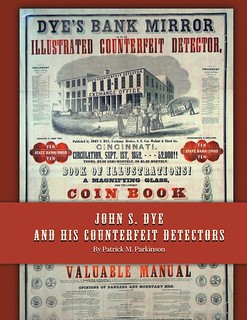 Recently published on Newman Portal is Patrick Parkinson’s work John S. Dye and His Counterfeit Detectors. This study documents the history of John S. Dye’s counterfeit detectors, a task made difficult by the ephemeral nature of such publications. Because new counterfeits and new genuine bank notes were constantly being circulated, counterfeit detectors quickly became outdated and were discarded, leaving very few surviving copies. This book fills in the gaps, largely through advertisements and articles in digital databases of contemporary newspapers. Parkinson’s work is meticulous and will be welcome by anyone interested in 19th century counterfeit detectors.
Recently published on Newman Portal is Patrick Parkinson’s work John S. Dye and His Counterfeit Detectors. This study documents the history of John S. Dye’s counterfeit detectors, a task made difficult by the ephemeral nature of such publications. Because new counterfeits and new genuine bank notes were constantly being circulated, counterfeit detectors quickly became outdated and were discarded, leaving very few surviving copies. This book fills in the gaps, largely through advertisements and articles in digital databases of contemporary newspapers. Parkinson’s work is meticulous and will be welcome by anyone interested in 19th century counterfeit detectors.
Lianna Spurrier performed book design, graphics, and layout of Parkinson’s work under sponsorship of Newman Portal. The result is an elegant presentation, with visual appeal matched only by the content. Newman Portal welcomes inquiries by prospective authors in need of the same services, and currently has similar projects in production, which will be announced in due course.
VIDEO: QUEEN VICTORIA'S NUMISMATIC FAMILY TREE
These are selections from the David Lisot Video Library that feature news and personalities from the world of coin collecting. David has been attending coin conventions since 1972 and began videotaping in 1985. The Newman Numismatic Portal now lists all David’s videos on their website at:
https://nnp.wustl.edu/library/multimediadetail/522852
Here's one on Queen Victoria's Numismatic Family Tree. -Editor
Queen Victoria's Numismatic Family Tree
American Numismatic Association Convention, Milwaukee, 2007.
Speaker: James Wells
 James Wells collected mainly American coins for decades, but became fascinated with the interconnection of European royalty and the coins that depict them. He has written for "Numismatist" and the "California Numismatist" as well authored a five-part series on Queen Victoria that appeared in "World Coin News" in 2004-2005. In this video lecture with PowerPoint you will see and learn:
James Wells collected mainly American coins for decades, but became fascinated with the interconnection of European royalty and the coins that depict them. He has written for "Numismatist" and the "California Numismatist" as well authored a five-part series on Queen Victoria that appeared in "World Coin News" in 2004-2005. In this video lecture with PowerPoint you will see and learn:
- lineage from which Victoria came to become Queen
- coins of Victoria in Great Britain and the five different portraits used
- coins and portraits from the 18 different countries on which she also appeared
- her 9 children and their marriages and the coins on which they appeared
- the 76 different countries on whose coins her children, siblings and in-laws appeared
- Elizabeth II who has appeared on more coins than anyone in history
The video is available for viewing on NNP at:
https://nnp.wustl.edu/library/book/557270
ANA TO DEACCESSION ITEMS ON EBAY
The American Numismatic Association is joining the American Numismatic Society with numismatic item sales on eBay, to include duplicate numismatic literature from the Dwight N. Manley Numismatic Library and redundant items from the Edward C. Rochette Money Museum. Here's the press release. -Editor
 The Money Museum operated by the nonprofit American Numismatic Association in Colorado Springs, Colo., announced that it will soon be selling – or deaccessioning, as the practice is known – select items from its collection that are redundant, mostly low-value specimens already well represented. The sales will be conducted on eBay and are anticipated to begin in June.
The Money Museum operated by the nonprofit American Numismatic Association in Colorado Springs, Colo., announced that it will soon be selling – or deaccessioning, as the practice is known – select items from its collection that are redundant, mostly low-value specimens already well represented. The sales will be conducted on eBay and are anticipated to begin in June.
No specimens from the Money Museum’s permanent collection will be sold.
The auctions will focus on world coins, paper money, tokens and medals, though a few American duplicate coins, mint sets and numerous stock certificates also will be included. The auction project will eventually expand to duplicate books and catalogs from the ANA Library and ANA-
THE JOURNAL OF NECROMANTIC NUMISMATICS
As part of last week's article on Paul Courville's book on Magic Tokens I learned about The Journal of Necromantic Numismatics. Paul kindly provided this additional background. Thank you! -Editor
 The Journal of Necromantic Numismatics (JNN) was a newsletter of sorts that was subscription based, but not in the conventional sense of subscription. In order to receive a copy you were invited to submit a ONE page article towards the creation of that issue, no article... no issue. This was devised by Bill Kuethe and was intended to be a quarterly produced item.
The Journal of Necromantic Numismatics (JNN) was a newsletter of sorts that was subscription based, but not in the conventional sense of subscription. In order to receive a copy you were invited to submit a ONE page article towards the creation of that issue, no article... no issue. This was devised by Bill Kuethe and was intended to be a quarterly produced item.
The first year only three issues were released (growing period) then it settled into quarterly for the next 4 years. then in the 6th year 2 issues were produced and then only one issue each of the next 6 years that followed. Bill would get the articles mailed to him. He would make copies of all the articles, add a front and back cover, staple all the pages together and then mail the copies to each of the contributing "subscribers". There are only a microscopic number of complete files in existence due to Kuethe’s novel distribution model for the journal.
Only one person that I am aware of has the entire 32 issues besides myself and that set is Bill Kuethe's personal copies that are in The International Museum and Library of the Conjuring Arts, which is in Las Vegas and owned by David Copperfield.
I removed the 50+ year old staples from my issues in order to be able to properly scan them all and when I finished I didn't want to attempt to slide staples through the original holes so each of the 482 pages are in top load document protectors and stored in the leather binders (with box sleeves) that I made to store them in.
NOTES FROM E-SYLUM READERS: MAY 9, 2021
Whitehead & Hoag Piece NOT a Magic Token
Magic Tokens book author Paul Courville also responded on that mysterious Whitehead & Hoag token some thought might be a magic piece. Thanks! The best thing about The E-Sylum is getting answers directly from people in a position to know. -Editor
Paul writes:
"The Fortuna item and about 30 others are NON-magic related items that I frequently get asked about. As Jud Petrie replied in the article, there are many collectors who have one or many unauthenticated items within their collections but they are in no way found to have any association to magic in any way but they have "that look" to them... I have a few of them in my junk token box because they were in the collections of Raymond Goulet, James Eastman and Micky Hades which I purchased over the years."
Paul also notes:
"My book is still in print and I updated its content just last week. It is available via Amazon, but then again... It's FREE on my website and the PDF version is searchable for quick searches."
To access the book online, see:
http://www.magictoken.org/magic/guide.html
To read the earlier E-Sylum articles, see:
A MYSTERIOUS WHITEHEAD & HOAG TOKEN
(https://www.coinbooks.org/v24/esylum_v24n15a07.html)
THE MYSTERIOUS WHITEHEAD & HOAG TOKEN
(https://www.coinbooks.org/v24/esylum_v24n16a11.html)
NEW BOOK: MAGIC TOKENS
(https://www.coinbooks.org/v24/esylum_v24n18a04.html)
Other topics this week include The Banknote Book, an unusual Mott token, and the Reis spurious Portugal banknote issues. -Editor
QUERY: GREENDUCK MOUSE AND TARZAN PIECE
Dick Johnson’s widow Shirley writes:
"A very interesting piece of Greenduck has just turned up. I wonder if anyone has seen it before. They certainly look like the old Mickey Mouse and Tarzan (maybe)."
The item was submitted by Dave Taber of Charlotte, Michigan via Shirley. Can anyone tell us more about it? A Tarzan fan club souvenir, perhaps? Ever wondered where the company's name came from? Here's an excerpt from Dick's encyclopedia. -Editor
Greenduck Company manufacturing firm, Chicago; relocated
Hernando, Mississippi 1962.
Also Green Duck Company [two words], Green Duck Metal
Stamping Company; Green Duck Corporation 1962-2004.
Founded 1906 by two partners, George G. Greenburg (formerly with Childs & Company) and Harvey Ducgheisel, choosing the name Greenduck as the first syllable of these two men's last names, intending it to be one word. However so many people used it as two words, it was adopted as two words by the company as well (date unknown). Firm produced wide assortment of metal stamped products, often lithographed in color on thin metal. An advertisement in 1930s listed four dozen different including campaign buttons, tabs, key tags, label buttons, and such in small size up to Illinois state license plates.
A large group of the firm’s archives was sold in a Hake’s Americana & Collectibles auction 19-21 January 2010.
MORE ON INFLUENCE IN NUMISMATICS
Pete Smith's review of the Coin World list of The Most Influential People in Numismatics brought forth a number of comments. I was unsure initially of how to handle this, hoping to avoid the rabbit-hole of directly or indirectly criticizing the inclusion or exclusion of people from an important-sounding list. But as always, our readers have made a number of interesting observations, and I've included all of them here with no more editing than usual for this publication. So here goes. -Editor
David Thomason Alexander writes:
 "I read with deep interest our friend Pete Smith's comments on Coin World's just-published review of "The Most Influential People in Numismatics." I believe it's a fact that recognizing one individual in any
field automatically antagonizes 100 who were not recognized. In my years
with the Numismatic Literary Guild I became quite familiar with the cry
"there are too many awards," by folks who really meant "I didn't get one!"
"I read with deep interest our friend Pete Smith's comments on Coin World's just-published review of "The Most Influential People in Numismatics." I believe it's a fact that recognizing one individual in any
field automatically antagonizes 100 who were not recognized. In my years
with the Numismatic Literary Guild I became quite familiar with the cry
"there are too many awards," by folks who really meant "I didn't get one!"
Coin World (CW) showed commendable precision in its wording "influential people in numismatics," side-stepping "great people in numismatics." A few years ago "influential" might have included Dr. William H. Sheldon, Walter Breen and Stanley Apfelbaum... CW touched on many bases in its kaleidoscope of recognition and a few of those recognized are newcomers to the commercial world. "Big deal dealers" are not the only people in the commercial sector, though they could be argued over for months or years! CW sought a wide selection and it certainly achieved it"
JEWISH-AMERICAN HALL OF FAME WEBSITE UPDATED
Speaking of Halls of Fame, here's a press release about the upgrading of the website of the Jewish-American Hall of Fame. -Editor
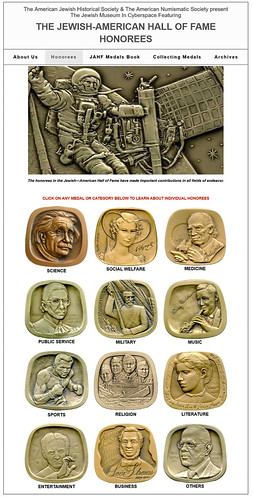 The Jewish-American Hall of Fame’s website www.amuseum.org made its first appearance on the Internet in 1996. In 2002, it won the Numismatic Literary Guild’s award as the Best Non-Commercial Website. In May, the newly expanded website makes its debut, just in time to celebrate Jewish American Heritage Month. Mel Wacks, Founding Director of the Jewish-American Hall of Fame, has worked for over a year to make this possible, along with programmer Sumera Manzoor.
The Jewish-American Hall of Fame’s website www.amuseum.org made its first appearance on the Internet in 1996. In 2002, it won the Numismatic Literary Guild’s award as the Best Non-Commercial Website. In May, the newly expanded website makes its debut, just in time to celebrate Jewish American Heritage Month. Mel Wacks, Founding Director of the Jewish-American Hall of Fame, has worked for over a year to make this possible, along with programmer Sumera Manzoor.
Over 60 pages have been added, featuring large photos of the Jewish-American Hall of Fame medals and texts that are easy to read on smart phones as well as computer screens. The new pages picture medals created by renowned medalists like Eugene Daub, Alex Shagin, Marika Somogyi, Paul Vincze and Gerta Ries Wiener. Pages are easily navigatable by topic, such as Entertainment, Military, Music, Science, Sports, etc. Honorees range from the famous (Albert Einstein, George Gershwin, Ruth Bader Ginsburg, Houdini, et al) to relatively unknowns (Gertrude Elion, Ernestine Rose, and Rosie
Rosenthal). In addition to biographies, an informative and entertaining video can be viewed for virtually every inductee. The old website, containing a Virtual Tour Through 500 Years of Jewish American History, Quizzes, The Harry Flower Collection of Einstein Medals, etc., has been kept intact and accessible in the Archives section of the revamped website. In addition, several books can be read on the website: The Handbook of Bibilical Numismatics
and Medals of the Jewish-American Hall of Fame
by Mel Wacks, and Antisemitic Bigotry on Historic Medals
by Dr. Benjamin Weiss.
BORCKARDT RECEIVES EAC'S SILBERMAN AWARD
And speaking of individual numismatists worthy of honors, here's the press release on Mark Borckardt recent award. Congratulations. -Editor
 Mark Borckardt, Senior Cataloger and Senior Numismatist at Heritage Auctions, has been awarded The Herbert Silberman Award by the Early American Coppers Club (EAC). The award is the EAC’s highest honor and is presented to individuals who have shown exceptional service to their fellow members and to numismatics in general.
Mark Borckardt, Senior Cataloger and Senior Numismatist at Heritage Auctions, has been awarded The Herbert Silberman Award by the Early American Coppers Club (EAC). The award is the EAC’s highest honor and is presented to individuals who have shown exceptional service to their fellow members and to numismatics in general.
Just 10 people have been granted the award during the last 40 years. In addition to Borckardt, longtime Heritage client and friend Denis Loring also received the award this year. The EAC is a community of collectors and researchers with a passion for the early copper coinage of the United States. Borckardt currently serves as the Early American Coppers’ National Historian.
This is well-earned recognition for Mark, a specialist who has dedicated his life to furthering the advancement of numismatic knowledge and research,
said Todd Imhof, Vice President of Heritage Auctions.
The award is named after the EAC’s creator, Herbert A. Silberman, who founded the club in 1967 along with 93 charter members.
MICHAEL OLSON RECEIVES MINT DIRECTOR’S AWARD
Louis Golino published a nice article on CoinUpdate about Michael Olson's U.S. Mint Director’s Award. Here's an excerpt - see the complete article online. -Editor
Michael Olson, a former member of the Citizens Coinage Advisory Committee who originally proposed the idea of commemorating the 50th anniversary of the 1969 Apollo 11 Moon landing and spearheaded passage of the legislation that created the set of coins issued in 2019 for that event, recently received a Director’s Award from U.S. Mint Director David Ryder for his major contributions to that coin program.
U.S. Mint directors have a longstanding tradition of awarding excellence among Mint employees with various awards including Rittenhouse medals modeled after one created in 1871 by Charles Barber that depicted the first U.S. Mint director, David Rittenhouse.
VOCABULARY TERM: DROP HAMMER PRESS
Here's another entry from Dick Johnson's Encyclopedia of Coin and Medal Terminology. -Editor
Drop Hammer Press. Pneumatic or gravity type press which delivers a hard sharp strike. Not suitable for coins or large medals, it can be used, however, for striking small, charm- size items; but is best suited for trimming or piercing. The reason for this is its quick acting force – ideal for shearing, trimming or piercing – but unsuitable for die striking (which requires time for metal flow with longer extrusion dwell). Despite this, attempts have been infrequently made to strike coins with drop hammer presses. The latest, in 1920, occurred when the large quantity of coins were required in England when it converted from silver to a quaternary coinage.
MORE ON DAVID ULYSSES PROSKEY (1853-1928)
Here's more from the David Prosky entry from the online draft of John Lupia's book of numismatic biographies. This is an excerpt with the full article and bibliography available online. -Editor
2. Second Period - 1877 - 1885 - John Walter Scott & Scott & Company.
 From 1877 to 1885 he worked for John Walter Scott in his firm Scott & Company. In 1877, David Proskey became the new editor of Scott's Coin Collector's Journal, and head of the coin and medal department. Proskey was editor of Scott's Coin Collector's Journal from Volume 2 (1877) to Volume 13 (1888).
From 1877 to 1885 he worked for John Walter Scott in his firm Scott & Company. In 1877, David Proskey became the new editor of Scott's Coin Collector's Journal, and head of the coin and medal department. Proskey was editor of Scott's Coin Collector's Journal from Volume 2 (1877) to Volume 13 (1888).
In 1879, Proskey was involved in creating the J. W. Scott & Co., 1861 Confederate half dollar restrikes from an original die.
HARVEY STACK'S NUMISMATIC FAMILY, PART 95
The latest article in Harvey Stack's blog series rounds out the year 1984. -Editor
In July 1984 Stack's once again, as we had since 1979, joined with joined with Rarcoa, Paramount and Superior to offer our popular "Apostrophe" auction, in this case Auction '84. As previously this event had a wealth of choice, rare and important coins, 500 lots from each company. The sale included 1802 and 1803 Proof silver dollars, 1884 and 1885 trade dollar Proofs, early Proof sets from the 1860s and more, early U.S. gold in mostly Mint State, an 1838-O half dollar, an 1800 Stella and an 1855 Round Kellogg $50 gold, just to mention some of the highlights.
Our September public auction featured a comprehensive offering that combined the collections Dr. George Kosko and Thomas A. Bergin, as well as duplicates from the Yale University Collections. It brought to auction all denominations of. U.S. coins from the half cent to the $20 double eagle, mostly in Choice Mint State and Proof condition. It was another Stack's sale that presented "something for everyone," which always attracted bidders in the thousands.
THE COIN ANALYST: CELEBRATING 10 YEARS
Writer Louis Golino recently celebrated a milestone - 10 years of "The Coin Analyst" column. Congratulations. Here's an excerpt from his CoinWeek piece. -Editor
After a decade and about 300 of these columns, it is time to take stock of what I have tried to do with this platform that has enabled me to continue growing as a numismatic writer and develop a wide range of contacts within the field.
Let me begin by taking the opportunity to thank each of you who has generously shared your insights with me and my readers. And let me thank my readers not just for reading the column but for your comments, feedback, and suggestions, which are all appreciated.
CHARLES I SHILLING AT MARYLAND COLONIAL FORT
The Washington Post reported that archaeologists found a Charles I shilling at a dig in St. Mary’s, MD, perhaps brought to the New World by English settlers in 1634. -Editor
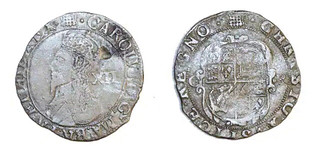 It was a silver shilling, bearing the likeness of the doomed King Charles I, and one day three centuries ago, someone lost it inside the Maryland colonial fort at St. Mary’s.
It was a silver shilling, bearing the likeness of the doomed King Charles I, and one day three centuries ago, someone lost it inside the Maryland colonial fort at St. Mary’s.
It was an elegant coin, showing the crowned king in profile with goatee and lace collar. It was probably missed by its owner, and probably searched for, in vain.
Last week, archaeologists announced that, about 380 years after it was lost, it turned up during the historic dig that recently uncovered the outlines of the fort at the first permanent English settlement in Maryland.
2021 ANS COINAGE OF THE AMERICAS CONFERENCE
The 2021 Coinage of the Americas conference theme has been announced by the American Numismatic Society. Here's the call for papers. -Editor
Coinage of the Americas Conference (COAC) 2021 Call for Papers
The Victor D. Brenner Sesquicentennial
 American Numismatic Society (ANS)
American Numismatic Society (ANS)
New York, New York
September 17–18, 2021
Submission Deadline: July 1, 2021
Email submissions and questions to Dr. Jesse Kraft, ANS Assistant Curator of Assistant Curator of American Numismatics at
jkraft@numismatics.org.
The American Numismatic Society is proud to announce the reintroduction of the Coinage of the Americas Conference (COAC). Since the mid-1980s, COACs have been considered the leading venue for the presentation of academic research that pertains to numismatics of the Western Hemisphere. The papers given at past COACs have routinely been published and resulted in a number of edited volumes. These texts have since become standard references on their respective topics. After 2009, COACs experienced a hiatus that will end with the upcoming conference this year.
THE BOOK BAZARRE
2021 ANA SUNDMAN AND MONEY TALKS SPEAKERS
The American Numismatic Association (ANA) is also planning an event - the 2021 World's Fair of Money convention in the Chicago suburb of Rosemont. Speakers are sought for the Sundman Lecture and Money talks series. -Editor
Symposium Overview:
Since the invention of coinage, certain coins have stood out for their beauty, their bold design or their sheer size. From the Decadrachms of Syracuse to the 1907 ultra-high relief Saint-Gaudens $20 and the modern monster coins,
this year’s Sundman lecture submissions should be based on the history behind big, bold and beautiful coins. Papers that emphasize new research and scholarship will be prioritized. Selected presenters will receive a $250 honorarium.
Submission Guidelines:
If you wish to be a speaker at the symposium, please submit a summary of your lecture, not to exceed 500 words. Each summary should contain an introduction, a brief discussion of the subject, and sources and research method. The deadline for submissions is June 4, 2021.
Free and open to all attendees of the World’s Fair of Money, the symposium will take place on Wednesday, August 11, 2021 at the Donald E. Stephens Convention Center in the Chicago suburb of Rosemont.
2021 ANA WORLD'S FAIR OF MONEY CONFIRMED
For more on the ANA convention itself, here's a press release published earlier this week. -Editor
Safety protocols may limit size of the show
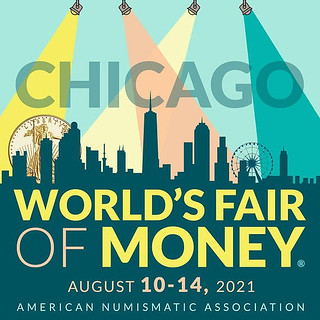 Coin collectors can breathe a sigh of relief.
Coin collectors can breathe a sigh of relief.
The Donald E. Stephens Convention Center in Rosemont, Illinois – a suburb of Chicago – announced on May 4 that it will resume hosting trade shows and events beginning in July, which is great news for those hoping to attend the American Numismatic Association's (ANA) World's Fair of Money (WorldsFairOfMoney.com), Aug. 10-14.
The convention center, one of the largest such facilities in the U.S., plans to reopen with the health and safety of attendees top of mind, which likely means adhering to social distancing, wearing masks and establishing disinfecting protocols. The convention center has not yet indicated whether limits will be placed on the number of people allowed in the event facility at one time.
ARCHIVES INTERNATIONAL AUCTION 67
Here is the announcement for the May 26, 2021 sale by Archives International Auctions. -Editor -Editor
ARCHIVES INTERNATIONAL AUCTIONS OFFERS HISTORIC 1927, PALESTINE CURRENCY BOARD, 5 POUNDS BANKNOTE RARITY ALONG WITH HUNDREDS OF RARE BANKNOTES, BONDS AND SHARES AT ITS MAY 26th , 2021 PUBLIC AUCTION IN RIVER EDGE, NEW JERSEY
The auction will be held by Archives International Auctions at their offices in River Edge, N.J.
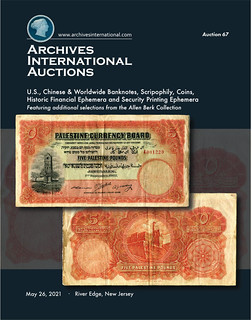 The May 26th, 2021 auction by Archives International Auctions is highlighted by a Palestine Currency Board, 1927, £5 Banknote Rarity as well as dozens of rare banknotes rarely seen at auction. Archives International will offer additional selections from the Allen Berk Worldwide Banknote Collection. This will be one of many auctions to feature Allen Berk’s numismatic treasures over the coming months. Auction 67 auction will consist of over 1000 lots of rare and desirable U.S. & World Banknotes, Scripophily, Coins, Historic Financial Ephemera and Security Printing Ephemera.
The May 26th, 2021 auction by Archives International Auctions is highlighted by a Palestine Currency Board, 1927, £5 Banknote Rarity as well as dozens of rare banknotes rarely seen at auction. Archives International will offer additional selections from the Allen Berk Worldwide Banknote Collection. This will be one of many auctions to feature Allen Berk’s numismatic treasures over the coming months. Auction 67 auction will consist of over 1000 lots of rare and desirable U.S. & World Banknotes, Scripophily, Coins, Historic Financial Ephemera and Security Printing Ephemera.
The 1927, Palestine Currency Board issue banknotes are all considered major rarities and are missing from almost every significant collection and rarely come up for auction
, stated Dr. Robert Schwartz, President of Archives International Auctions. Also included in the auction are a wide variety or rare and desirable banknotes, many having been off the market for decades or are new to the collecting community, that will enhance the collections of every level of collector and dealer
.
MORE HOLABIRD MAY 2021 SALES SELECTIONS
Here are some numismatic lots in the upcoming Holabird sale. -Editor
14K gold-plated Sterling silver belt buckle, intricately carved, with an 1899 S $20 double eagle gold coin mounted in the center with the reverse visible through a hole in the back of the buckle. Buckle is approx. 3.75 x 2.25 inches, and weighs ~3.39 troy ounces (~105.6 grams) including the coin. Buckle is marked on the back / STERLING / HE / 14 K GOLD /. Coin is in VF/XF condition, and the buckle shows very little wear in the ornate carving on the front.
FOUNDATIONS OF THE FIRST MONETARY SYSTEM
This article discusses the bronze age origins of the first monetary system. Found via The Explorator newsletter. To subscribe to Explorator, send a blank email message to: explorator+subscribe@groups.io. -Editor
Long before cryptocurrencies , mobile payments and investments in the stock market, the economy of an area was based on exchanging a surplus good for another that was needed. Until the advent of coins and bills, bartering was the only known form of trade. A new study suggests that the germ of what we now know as the European economic system appeared at the end of the Bronze Age , thanks to the popularization of a measurement system and countless bronze fragments that functioned as currency.
PAQUET 1861-S DOUBLE EAGLE OFFERED
Stack's Bowers Senior Numismatist and Consignment Director James McCartney published a short blog article about about a Paquet Double Eagle in the firm's upcoming June sale. -Editor
The 1861-S Paquet Reverse is perhaps the most famous collectible Type I double eagle and is recognized well beyond the specialists of the series. Anthony C. Paquet was born in Hamburg, Germany on December 5, 1814, and arrived in Philadelphia in 1848. In early 1857, he took up contract work for the Philadelphia Mint before finally being hired on as an assistant engraver. By far his most well-known work is the United States military's highest decoration for valor, the Medal of Honor instituted by President Abraham Lincoln on July 12, 1861. Among his other projects at the Mint were a series of unsigned pattern coins, including a fascinating copper double eagle pattern, Judd-257. To this day, the reverse dies he prepared for the 1861 double eagles remain the only coin designs that have been positively attributed to Paquet, who left the Mint in 1864.
U.S. COIN COMPOSITION CHANGES
As a data guy I'm partial to a good infographic. A couple weeks ago we discussed a U.S. Mint website article which reviewed 100 years of silver dollar coinage. Here's another article with a decent infographic summarizing changes to U.S. circulating coin composition over the years. The article also has two nice image galleries showing coin production methods in the pre- and post-steam eras, plus a video of modern coin production. See the complete article online for more. -Editor
The U.S. Mint has produced coins for this nation for over 225 years. Coin production evolved from slow horse- and man-powered machinery to fast computer-controlled machines. Explore the history of coin production and how the process changed through the years.
Coinage at the First Mint
When the U.S. Mint first opened in 1793, coin production was a very physical, slow, and imprecise process. The first Mint in Philadelphia consisted of a three-story brick building along with a series of smaller buildings housing crude horse- and man-powered machinery. The Mint lacked experience designing and engraving coins, and coin production got off to a slow start.
The Coinage Act of 1792 authorized the Mint to produce copper, silver, and gold coins for circulation. The Act specified that the government must buy the copper needed to coin half cents and cents (as raw material or as blank coins already the appropriate size for coining). But depositors such as banks and individuals provided the silver and gold. The silver and gold were either in the form of foreign coins or bullion that the Mint melted down and refined to the appropriate fineness for coining...
1854 RESCUE OF THE S.S. SAN FRANCISCO MEDAL
The June 2021 Stack's Bowers Numismatic Americana auction includes this rare medal commemorating the rescue of the S.S. San Francisco. Here's an excerpt from the lot description - see the complete text online. -Editor
1854 Merchants and Citizens of New York Medal for the Rescue of the S.S. San Francisco. Dies by C.C. Wright, struck and assembled by Ball, Black, & Co., New York. Silver. Choice About Uncirculated.
45.5 mm. 756.1 grains. Housed in an original applied rope bezel and loop with anchor decoration, as made. Awarded to Robinson Miller of the Lucy Thompson. Engraved on the reverse in multiple lines: PRESENTED TO ROBINSON MILLER, A SEAMAN ATTACHED TO THE AMER: SHIP "LUCY THOMPSON," BY THE MERCHANTS AND CITIZENS OF NEW YORK AS A TESTIMONIAL OF THEIR DEEP SENSE OF HIS HUMANE AND COURAGEOUS CONDUCT IN ASSISTING TO RESCUE THE PASS-ENGERS, OFFICERS, & CREW OF THE STEAMER SAN FRANCISCO IN THEIR PERILOUS EXPOSURE ON THE OCEAN, AFTER THE DESTRUCTIVE GALE OF THE 24 DECEMBER, 1853.
CONFEDERATE MONEY AFTER THE CIVIL WAR
This article by Colorado State University history professor Colorado State University addresses the question, "What happened to Confederate money after the Civil War?" It's got a great photo from the National Archives. -Editor
At the time the Civil War began in 1861, the United States government did not print paper money; it only minted coins. As a historian of the American Civil War, I study how the Confederate government used a radical idea: printing paper money.
In 1861, 11 states tried to leave the United States and form a new country, causing a four-year war. Wars cost a lot of money so the new country, called the Confederate States of America, printed money as a way to pay its bills.
THE BOOK BAZARRE
VIETNAMESE PHAN BOI CHAU NOTES
Howard Daniel writes:
"I was contacted a couple of months ago by a friend about a sample book discovered in China (or Hong Kong) with three Vietnamese paper items in it and which were offered to Kelvin Cheung of Spink & Son, the branch of a London-based auction firm in Hong Kong. My friend and Kelvin did not know exactly what they were so my friend knew I probably had the knowledge about them. When I saw the images, I literally jumped up from my chair! They were samples of the earliest of Phan Boi Chau’s notes
and completely unknown to anyone knowing they actually exist, and they were absolutely unique. Their existence had to remain confidential until Kelvin owned them.
"I did not hear or read more about them until I received an email from a authenticator at PMG. My name had been given to the authenticator to work on getting them slabbed. I got some better images, colors (I am partially color-blind!) and measurements of them and rewrote my catalog pages to include the three notes so the authenticator could read the complete story about them. There are now five unique pieces known! We worked on the label and a grader completed the work for them to be slabbed. I am praying that I got everything right about them!
"I contacted Kelvin about what happened and we corresponded about it. I sent him my new draft pages for all of Phan Boi Chau’s unique pieces and he asked me to allow him to put them in his auction catalogue. I agreed and one of his staff, Joseph Lam, worked on the catalog pages."
LOOSE CHANGE: MAY 9, 2021
Here are some additional items in the media this week that may be of interest. -Editor
Over on the Coin Talk forum there's a nice discussion of Felix Schlag’s original Jefferson Nickel design, including some photos of Monticello.
In 1938, Felix Schlag won a $1,000 award for his Jefferson Nickel design. Schlag won the award in a competition that involved 390 or over 400 other artists, depending upon your source of information.
Schlag’s victory continued a policy that Theodore Roosevelt had initiated in 1907 when he asked Augustus St. Gaudens to redesign American coinage. St. Gaudens work was ultimately limited to the $10 and $20 gold coins, but it set the trend. From 1907 until 1938, outside artists created all of the new designs for regular issue coins. That string would not be broken until Mint Director, Nellie Tayloe Ross, pushed hard to give John Sinnock the opportunity to design the Roosevelt Dime in 1945-6.
Recently, engraver, Ron Landis, issued 100 sets of the Jefferson Nickel with original Felix Schlag design. Landis first issued coins like this in the early 2000s for the Full Step Jefferson Nickel Club.
To read the complete thread, see:
Felix Schlag’s original Jefferson Nickel design
(https://www.cointalk.com/threads/felix-schlag%E2%80%99s-original-jefferson-nickel-design.379075/)
Other topics this week include the 2003 Arkansas State Quarter, the Philadelphia Museum, and early American college secret society medals. -Editor
FEATURED WEB SITE: MEDAL COLLECTORS OF AMERICA
This week's Featured Web Site is the Medal Collectors of America.
Medal Collectors of America was founded in 1998 as a club dedicated to the study and collection of artistic and historical medals. Our goal is to encourage research and publication in the medal field, while bringing together all who are interested, through meetings, publications, and other activities. Our magazine, The MCA Advisory, is published quarterly in both print and electronic versions, and we encourage submissions from both newcomers and experienced researchers. We hold two meetings a year, which are open to all, featuring guest speakers on a wide range of topics relating to medal collecting. One is held in August in conjunction with the American Numismatic Association convention, and the second in January in conjunction with the New York International Numismatic convention. One of the greatest benefits to membership is the opportunity to acquire our annual medal, which is struck in very limited quantities and available only to members.












